Ripley Entertainment Inc.'s Blog, page 331
July 13, 2018
Man Trims Fingernails After 66 Years!
Featured in Ripley's Believe It or Not!
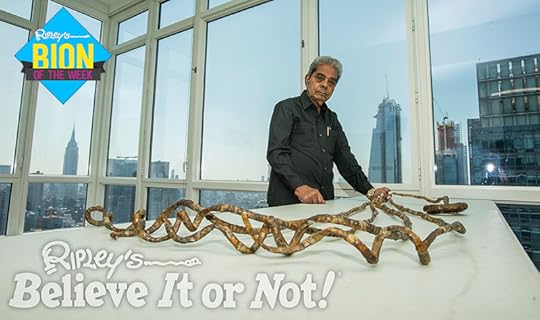
[July 8-14th, 2018] Encouragement to eat bugs, a woman accidentally steals a car, and the man with the longest fingernails gets a manicure.
Eat Bugs To Save Trees
Local officials in the Zhejiang Province in China have come up with a new way to keep pesky insects from eating the public greenery. They’ve begun encouraging locals to eat cicadas. They hope people get a taste for the bug and can successfully cull their numbers enough to keep the pests from killing trees and shrubs on public lands.

Woman “Accidentally” Steals Car
According to the Cornwall Community Police, a woman in Ontario accidentally stole a car for two weeks. After driving around the stolen Infiniti QX50 without incident it was a car rental salesperson that caught the elderly criminal. Apparently, she has rented a black sedan from him, then driven to. Nearby Walmart to do some shopping. When she came back outside, she just remembered her rental had been black and got in the hatchback—which used a keyless entry remote which the owner had left in the vehicle.

Giant Squirrel Statue
Residents of Almaty, Kazakhstan, are going nuts over a 40-foot squirrel statue erected in the center of the city. Made from straw and wood attached to a wire frame, the curious rodent towers over cars and pedestrians. The artist says its meant to symbolize nature’s role in urban life, but most people seem to think it was a waste of money—costing $67,000!
When the people of Almaty wake up tomorrow they will be confronted by a building-size effigy of a dead-eyed squirrel. Suspect a “Wicker Man a la Kazakh” scenario is unfolding here. What fun! #Kazakhstan pic.twitter.com/brVqGQSjli
— Peter Leonard (@Peter__Leonard) July 9, 2018
Avozilla
Avocados that are five times the size of regular ones have finally made their way out of South Africa. Arriving in Australia, these giant fruits are about the size of a person’s head and weigh over 2.5 pounds. No word yet on whether they’ll be coming to the U.S. anytime soon since farmers have to pay royalties to the original farm.
It’s the avocado the world needs, but doesn’t deserve… https://t.co/BL4nnlvPLO #Avozilla pic.twitter.com/Veu11CCyoh
— Matt Brann (@MattBrannRURAL) July 10, 2018
Longest Fingernails Cut After 66 Years
After growing his fingernails to a staggering 350 inches, Shridhar Chillal of Pune, India, decided it was finally time to trim his fingernails. After 66 years of growth, he’s proud to display them at Ripley’s Believe It or Not!
Gateways To Hell Part II
Featured in Ripley's Believe It or Not!

We showed you five of the scariest portals to the underworld last week, but we’ve got five more mysterious gateways for your final destination getaway.
FENGDU GHOST CITY, Chongqing, CHINA
This large complex of temples and shrines dedicated to the afterlife is located along the Ming mountain, about 100 miles downstream from Chongqing on the Yangtze River. Dating back nearly 2,000 years, the site has now become a tourist attraction, as people can take a boat, then an open-air escalator up to the temples, where many of the temples show shrines, paintings, and sculptures of people being tortured for their sins. Must be a blast, huh? Combining Confucianism, Taoism, and Buddhism, the Ghost City earned its name long ago, when two imperial officials—Yin and Wang—came to practice Taoism and became immortal. When combined, their names are translated to “King of Hell.”
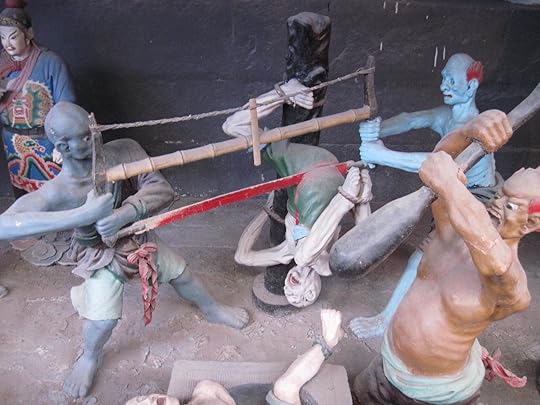
PATRICK’S PURGATORY, County Donegal, IRELAND
This ancient pilgrimage site on Station Island, Ireland, is legendary because it is the place where, in the fifth century, Jesus supposedly told St. Patrick there was a cave that led to Purgatory. It has been located on maps since the 12th century and seems to have held importance ever since. As the story goes, St. Patrick, sad because his followers doubted him and wanted to see proof of his teachings, prayed to God. Christ then showed him the entrance to Purgatory as proof, which he could then show to his own followers. The cave has always been associated with healing and spiritual powers, as it acts as a natural sauna.
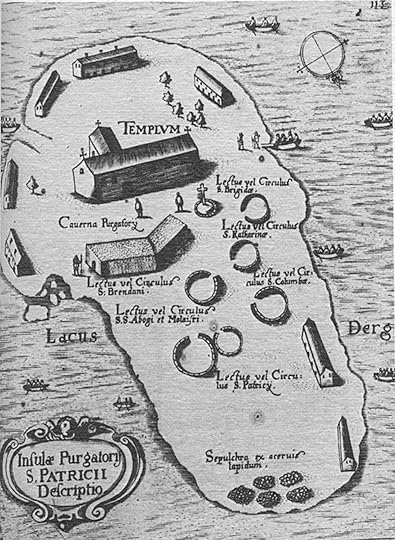
HOUSKA CASTLE, Blatce, CZECH REPUBLIC
Built just north of Prague in the 13th century, this early Gothic castle is notable because of what lies underneath it. Its chapel was built over a large hole in the ground, which was called a “gateway to Hell” — allegedly so deep that no one could see the bottom. Apparently, the things that crawled out of the hole were the stuff of nightmares: half-human, half-lizards, as well as things that looked like flying dragons. In fact, the castle was actually constructed to keep all the monsters inside. Legend has it, prisoners were brought in to be lowered into the hole just to see what was down there, and the first man screamed so much he was hauled back up, where he looked like he’d aged 30 years.

CC Mirek256
CAVE OF THE SIBYL, Monte Di Cuma, ITALY
This story comes from the Aeneid, penned by the legendary Roman poet Virgil in 19 BC. It chronicles the adventures of the Trojan warrior Aeneas, who happens upon a fortune teller, or Sibyl, in a cave in what is now known as Naples, Italy. In the story, the Sibyl guides Aeneas through the Underworld. But it was not the first time the site had been referred to as an opening to Hell. Nor would it be the last. The Sibyl and the cave also appeared in, among other places, the works of Ovid, in Dante’s Inferno, in Michaelangelo’s Sistine Chapel and in T.S. Elliott’s poetry. In 1932, archaeologist Amedeo Maiuri found the cave, which cemented the folkloric status of southern Italy with the mythical Underworld.

CC Bobbylamouche
ROOM 428, WILSON HALL, OHIO UNIVERSITY, Athens, OHIO
Why is room 428 in Ohio University’s Wilson Hall now sealed off to students? Is it because, as school officials say, it is uninhabitable for the pupils? Is it because a former student practiced the occult there? Is it because another student took her own life there? Or is it because it sits right in the middle of a pentagram between five other cemeteries, making it a portal to Hell? Maybe it’s a combination of all, as the pretty Ohio campus seems to be nestled right in the middle of Spooky Central. Long thought to be one of America’s most haunted campuses, few students graduate from Ohio U. without a creepy story.

By Ryan Clark, contributor for Ripleys.com
Source: Gateways To Hell Part II
CARTOON 07-13-2018
July 12, 2018
Did Pocahontas Love John Smith And Save His Life?
Featured in Ripley's Believe It or Not!

Or Not
In today’s world many misconceptions have been perpetuated—becoming modern day “facts”—when, in reality, myths and hearsay have taken over. Sorry to burst your bubble, but in this weekly column, Ripley’s puts those delusions to the test, turning your world upside down, because you can’t always…Believe It!
Today: Pocahontas and John Smith.
Disney and some other versions of the Pocahontas story depict the Englishmen John Smith as a man who falls in love with an Indian princess who saved his life. Smith even wrote in his book Generall Historie of Virginia that the young Native American woman put her own life in jeopardy twice in order to spare his. In reality, Pocahontas too young for romance when she met Smith, and she didn’t prevent his death.
The pair did have a relationship, but it was possibly more like brother and sister and political in nature, according to historian David Silverman of George Washington University.
Pocahontas was born around 1596. Her real name was Amonute, but she was also known privately as Matoaka. She was given the nickname Pocahontas, which has been translated several ways, including “playful one” and “ill-behaved child.”
When the English settled Jamestown in 1607, Pocahontas was about 11 years old. Her father was Chief Powhatan, and she was his favorite child. Powhatan ruled over 30 tribes in the area, and his brother, Opechancanough, captured Smith, who was 27 years old. In the Englishman’s version of events, when he met the chief, his head was placed on top of two stones on the ground with a warrior on standby ready to crush his skull. Then Pocahontas intervened and prevented the execution.
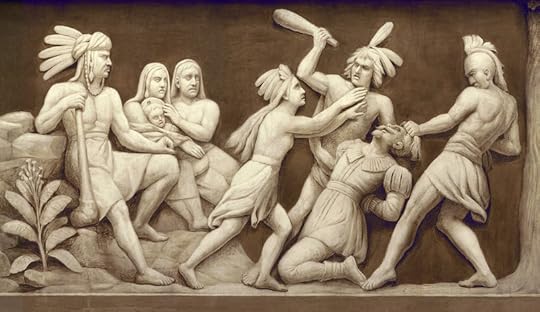
It’s unclear if this is how things actually played out. Several scholars believe the mock execution was actually an adoption ceremony and that the Algonquins never had any intention of killing Smith, who likely did not understand what was happening. Some have suggested that Smith was seen as a white werowance, or tribal chief. When Chief Powhatan met the Englishman, he was dazzled by his confidence and the pocket compass he carried. As a result, Powhatan adopted him as a subordinate werowance and named Smith a member of the tribe, referring to him as his son. The pair also exchanged gifts—Powhatan received two guns and a grindstone, and Smith was granted Capahowasick on the York River.
Pocahontas was very unique among young Native American girls at that time, who were tasked with jobs such as farming, cooking and making supplies for the home. Even though Jamestown was full of armed foreign men who were known to be hostile towards Indians, Pocahontas wasn’t intimidated. She bravely allied with Smith to ease relations between the Indians and settlers. She led Indian delegations to supply Jamestown residents with food and was also able to negotiate the release of Indian captives. The English viewed Pocahontas as a symbol of peace. She was not a threat because she was a child, and they knew she was Chief Powhatan’s favorite daughter.

Eventually, tensions grew between the Powhatan tribes and the English settlers. Food was scarce, and negotiations crumbled. After crops failed to grow, Smith and the other settlers became desperate, threatening village leaders if they didn’t help them.
Smith claimed in his book that Powhatan planned on killing him, but Pocahontas went to his hut and warned him in advance around 1608. Scholars believe this is false for several reasons. First, Pocahontas would have had trouble doing anything in secret because her father was the chief and her actions would have been noticed. Also, Powhatan had already offered to supply more provisions to the settlers.
In 1609, Smith was injured in an accidental gunpowder explosion and returned to England for treatment. By this point, Pocahontas was a teenager and of marriageable age. Some believe that in 1610 she married a man named Kocoum, who was not a chief and did not have a high-status position. It’s possible she married for love.
In 1613, Pocahontas was kidnapped. In some accounts, Kocoum was killed. While captive, Pocahontas converted to Christianity and was given the name Rebecca. She wed Englishman John Rolfe in 1614, and they had a son, Thomas, the following year. The family traveled to England in 1617, where she reunited with Smith before contracting a respiratory illness and dying in the ironically named town of Gravesend.

By Noelle Talmon, contributor for Ripleys.com
CARTOON 07-12-2018
July 11, 2018
Tightrope Daredevil Extraordinaire: The Great Blondin
Featured in Ripley's Believe It or Not!

Charles Blondin was born Jean-Francois Gravelet in 1824 France. Spending a lifetime performing miraculous stunts on a tightrope, he is considered the world’s greatest funambulist—tightrope walker—of the 19th century.
Beginning his career as an acrobat when he was just five years old, it took Blondin a mere six months to premiere as “The Boy Wonder.” His skill at gymnastics and natural affinity for grace quickly propelled him into the spotlight. He became known as the Great Blondin for his signature blond hair.
After a career in Europe, Blondin headed for North America to seek fame and fortune.
In 1859, he walked a tightrope spanning the Niagara Gorge and became the first successful tightrope walker to accomplish the stunt. The rope was just two inches wide and spanned a 1,100-foot gap 160 feet above the raging water. Merely walking across wasn’t enough for Blondin though. On his first attempt, he stopped midway to pull up a bottle of wine from a boat below and had a small drink standing above the dangerous waters. Once he completed his crossing, he carried a daguerreotype camera back onto the rope to take a photo of the onlooking crowds. He always performed without nets or safety harnesses, believing they only invited trouble.

Niagara would become Blondin’s second home as he repeated the stunt numerous times adding evermore daring feats to the task. He made the journey backward, blindfolded, in a sack, somersaulting, locked in chains, on stilts, and carrying people on his back. Another stunt involved carrying people across in a wheelbarrow, his greatest passenger, however, was a lion! Though newspapers and writers like Mark Twain were not kind of Blondin—calling him reckless and an “adventurous ass”—the public at large was captivated by the morbid possibility of Blondin. Thousands of people, even including US presidents, watched in awe as he did what seemed impossible.
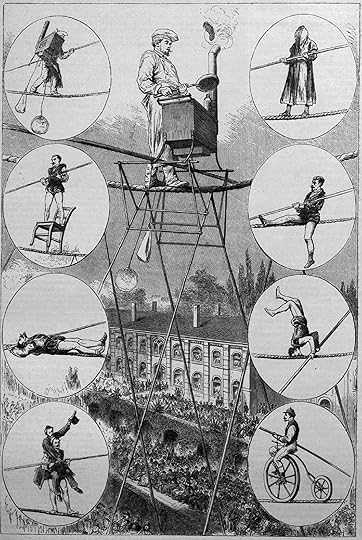
The first time he carried someone on his back, he chose his own manager, Harry Colcord, admitting to his friend that the stunt could go poorly. He told his manager to become one with himself, and not to try balancing on his own. Indeed, as they walked over the rope, several of the attached guy-lines snapped.
Blondin’s balance was so good that he was able to stop mid-rope and eat an omelet off a small table while sitting in a chair balanced on the rope. News of his aerial daredevilry became so widespread that his very name became synonymous with tightrope walking. He traveled back and forth to Europe performing for huge crowds putting on his final performance at the age of 72 after walking an estimated 10,000 miles on a tightrope.
Source: Tightrope Daredevil Extraordinaire: The Great Blondin
Clipping The World’s Longest Fingernails Straight From India!
Featured in Ripley's Believe It or Not!
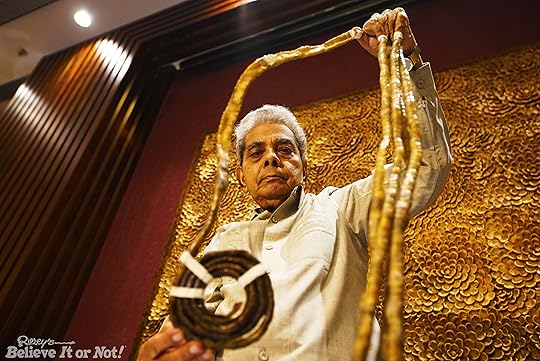
After 66 years, it was time for a manicure. But for Mr. Shridhar Chillal of Pune, India, the clippers weren’t going to cut it.
With the longest fingernails in the world—over 350 inches—Chillal hadn’t cut his nails since 1952!
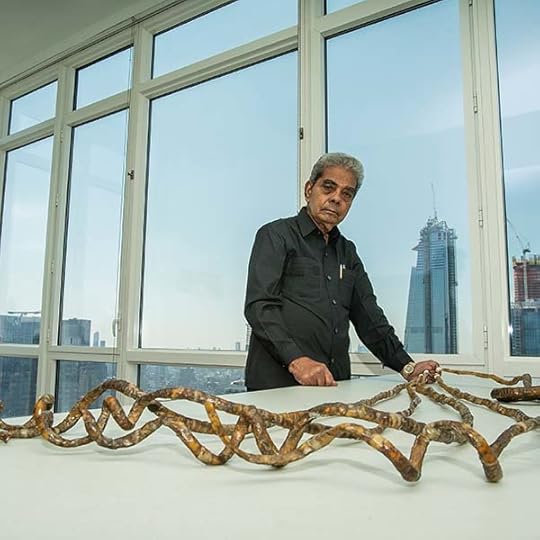
Nailed It!
Embarking on his journey at the age of 14, Chillal decided to grow his nails when he was scolded by his school teacher for accidentally breaking the teacher’s long nail—a sign of status in India.
Historically, it is considered a sign of wealth for a man to have at least one long nail in Chillal’s home country. It shows that the clawed does not have to do manual labor, particularly if it is kept clean and in good condition. Believe it or not, during the Qing dynasty, even women of the imperial Chinese court kept long nails to signify the same, going as far as to wear elaborate jeweled fingernail guards.
The teacher said that Chillal would never understand the importance of what he had done because Chillal had never committed to anything.
“I took it as a challenge,” said Chillal, and there was no looking back.
But, How Does He…?

Chillal’s unusual choice didn’t stop him from leading a normal and happy life. He married, has two children, three grandchildren, and enjoyed a successful career as a Government Press Photographer. However, as he aged, his long nails proved more challenging to maintain an ordinary lifestyle. He found it difficult to sleep, and even a gust of wind was cause for alarm.
Chillal chose to only grow the nails on his left hand. Due to years of growing his nails and the weight of the nails, his hand is permanently handicapped. He cannot open his hand from a closed position or flex his fingers.
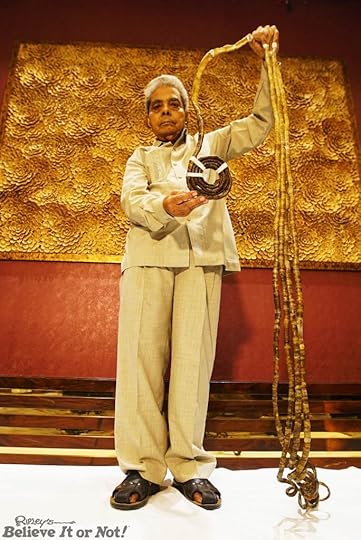
Forever Weird
After decades of dedication, enough was enough. It was time to memorialize the longest fingernails in the world. Ripley’s flew Chillal from India to the United States to cut his nails and forever memorialize them in Ripley’s Believe It or Not! Times Square.
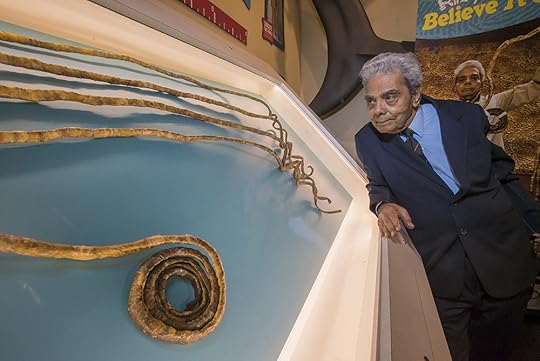

On display, believe it or not, his cut fingernails, laid flat, span a length of over 31 feet—the height of a three-story building!

Source: Clipping The World’s Longest Fingernails Straight From India!
Why Is Chelsea Football Club Fixated On Celery?
Featured in Ripley's Believe It or Not!

Soccer may have some odd traditions, but did you know that Chelsea Football Club has become notorious for their fans’ celery-based violence? The vegetable has even been banned from the grounds!
Celery? Really?
That’s right. Celery, one of the most harmless and uninteresting vegetables of all (and in the vegetable world, that’s really saying something), a vicious weapon! How did all of this come about? Let’s start at the beginning.
As with a lot of these peculiar traditions, the origins are a little difficult to pinpoint. Some accounts suggest that the concept of throwing celery onto the pitch began with the fans of lower-league side Gillingham, back in the 1980s. Before the football season began, celery would grow on their home pitch, according to the stories. Football fans are notorious for their lurid chants, and somewhere along the way, the two things became connected.
Others would tell you that this practice began with Mickey Greenaway, a huge fan of Chelsea, who heard a certain smutty song and began repeating it at Stamford Bridge, Chelsea’s home ground. Whatever the case, celery has become inextricably connected to the team. Some fans have been known to pelt opposing players with the vegetable when they come into range of the stands!

Katatonia82/Shutterstock
Curtailing The Celery Threat
As it turns out, some people don’t appreciate high-velocity vegetables bouncing off their heads. Fancy that! There have been several reports of celery-based incidents and arrests, including a well-publicized fracas in April 2002. At the semi-final of the F.A Cup against Fulham, five Chelsea fans were arrested for throwing volleys of vegetables. In court, they were released after the defense argued that this odd celery tradition was… well, just that. A tradition. A ritual act, if you will.
Just a few years later, though, the authorities dramatically flip-flopped with that opinion. Early in 2007, Chelsea banned celery from Stanford Bridge. A statement on the club’s official website reminded fans that: “The throwing of anything at a football match, including celery, is a criminal offense for which you can be arrested and end up with a criminal record. In future, if anyone is found attempting to bring celery into Stamford Bridge they could be refused entry and anyone caught throwing celery will face a ban.”
That’s a tough break for anybody just wanting to bring a healthy salad to eat while they watch the match, isn’t it? Most bizarrely, the statement included a hotline number, which people could call if they saw anybody in possession of the illicit vegetable.

The Proud Celery Tradition Lives On
While this lead to a dramatic decline in the amount of celery seen around the ground (and it’s a rarity these days), the rules are made to be broken. At away games, the celery does still come out at times. Much to the confusion of every other team’s supporters.
Most notably, in 2015, the Sky Sports News reported on Chelsea’s victory parade through London after winning the Premier League. Reporter Enda Brady was pelted by a hail of celery, live on the air. “Loads of celery live on Sky News,” said Brady. “Love it, love it, love it! It helps that I’m a Liverpool fan.”
So, there it is. The origins of this curious practice are still a little mysterious, but what a story it makes. I’m sure nutritionists everywhere admire the supporters, for their efforts in reminding everybody about the importance of getting your 5-a-day.
By Chris Littlechild, contributor for Ripleys.com
CARTOON 07-11-2018
July 10, 2018
The Prison Shirt Of Notorious Cult Leader Charles Manson
Featured in Ripley's Believe It or Not!

Born Charles Maddox in 1934, the details of notorious cult leader and murderer Charles Manson are foggy at best. Given his later penchant for manipulation and mental illness, biographers, attorneys, and journalists have been wary of Manson’s self-reported childhood, but they can be sure it was a rough one. Rumors go as far to claim that his mother sold him for a pitcher of beer.
In and out of reform schools beginning at age 12, Manson was often protected by his mother, keeping him out of prison and confined to her care, or the care of harsh non-prison institutions. Eventually, however, in 1956 his criminal life began in earnest and he was locked away for short period before being turned over to the care of his mother.
For the next 15 years, Manson led a life of crime stealing cars, managing prostitutes, committing sexual assaults, and eventually positioning himself at the center of a murderous cult known as the Manson Family. To get there he embedded himself in the bustle of California, meeting a member of the beach boys and pursuing a short music career.
The Manson Family
After assembling a group of followers, he instructed them to commit murders that would shock the nation. Specifically targeting the homes of those connected to the entertainment community, including director Roman Polanski, actress Sharon Tate, and Abigail Folger—heiress to the Folger coffee empire.
Eventually caught, Manson appeared in court with an “X” carved into his forehead defending himself in court with the help of attorney Irving Kanarek. He was declared guilty after seven months in court and delivered a death penalty, however, the California Supreme Court abolishes the death penalty before he is executed, commuting his sentence to life in prison with the possibility of parole.
Believe it or not, Manson could have walked free from his first parole hearing after serving just seven years in prison. In 1975, however, free Manson Family member Lynette “Squeaky” Fromme attempted to assassinate President Gerald Ford in the name of Manson, raising public ire against the cult leader. As other member came to blame Manson for manipulating them into murders, Charles Manson was repeatedly denied parole until his death in 2017.
Source: The Prison Shirt Of Notorious Cult Leader Charles Manson
Ripley Entertainment Inc.'s Blog
- Ripley Entertainment Inc.'s profile
- 52 followers







